Battle of Dunkirk
| Battle of Dunkirk | |||||||||
|---|---|---|---|---|---|---|---|---|---|
| Part of the Battle of France in the Second World War | |||||||||
A British soldier on Dunkirk's beaches fires at strafing German aircraft[1] | |||||||||
| |||||||||
| Belligerents | |||||||||
|
|
| ||||||||
| Commanders and leaders | |||||||||
|
|
| ||||||||
| Strength | |||||||||
|
approx. 400,000 338,226 evacuated[5] | approx. 800,000 | ||||||||
| Casualties and losses | |||||||||
|
11,000 dead 40,000 captured 50,000 vehicles (including tanks) 9 destroyers 200 marine vessels 145 aircraft |
20,000 dead and wounded 100 tanks 156 aircraft | ||||||||
The Battle of Dunkirk took place in Dunkirk, France, during the Second World War between the Allies and Nazi Germany. As part of the Battle of France on the Western Front, the Battle of Dunkirk was the defence and evacuation of British and Allied forces in Europe from 26 May – 4 June 1940.
After the Phoney War, the Battle of France began in earnest on 10 May 1940. To the east, the German Army Group B invaded the Netherlands and advanced westward. In response, the Supreme Allied Commander—French General Maurice Gamelin—initiated "Plan D" and entered Belgium to engage the Germans in the Netherlands. The plan relied heavily on the Maginot Line fortifications along the German-French border, but German forces had already crossed through most of Holland before the French forces arrived. Gamelin instead committed the forces under his command, three mechanised armies, the French First and Seventh and the British Expeditionary Force (BEF) to the River Dyle. On 14 May, German Army Group A burst through the Ardennes and advanced rapidly to the west toward Sedan, then turned northward to the English Channel, in what Generalfeldmarschall Erich von Manstein called the "Sickle Cut" (known as "Plan Yellow" or the Manstein Plan), effectively flanking the Allied forces.[6]
A series of Allied counter-attacks—including the Battle of Arras—failed to sever the German spearhead, which reached the coast on 20 May, separating the British Expeditionary Force (BEF) near Armentières, the French 1st Army, and the Belgian Army further to the north from the majority of French troops south of the German penetration. After reaching the Channel, the German forces swung north along the coast, threatening to capture the ports and trap the British and French forces before they could evacuate to Britain.
In one of the most widely debated decisions of the war, the Germans halted their advance on Dunkirk. Contrary to popular belief, what became known as "the Halt Order" did not originate with Adolf Hitler. Gerd von Rundstedt and Günther von Kluge suggested that the German forces around the Dunkirk pocket should cease their advance on the port and consolidate, to avoid an Allied breakout. Hitler sanctioned the order on 24 May with the support of the Oberkommando der Wehrmacht (OKW). The army was to halt for three days, which gave the Allies sufficient time to organise the Dunkirk evacuation and build a defensive line. Despite the Allies' gloomy estimates of the situation, with Britain even discussing a conditional surrender to Germany, in the end more than 330,000 Allied troops were rescued.[7]
Prelude
On 10 May 1940, Winston Churchill became Prime Minister of the United Kingdom. By 26 May, the BEF and the French 1st Army were bottled up in a corridor to the sea, about 60 mi (97 km) deep and 15–25 mi (24–40 km) wide. Most of the British forces were still around Lille, over 40 mi (64 km) from Dunkirk, with the French further south. Two massive German armies flanked them. General Fedor von Bock's Army Group B was to the east, and General Gerd von Rundstedt's Army Group A to the west. (Both these officers were later promoted to field marshal.)[6]
Halt order
During the following days... it became known that Hitler's decision was mainly influenced by Goering. To the dictator the rapid movement of the Army, whose risks and prospects of success he did not understand because of his lack of military schooling, became almost sinister. He was constantly oppressed by a feeling of anxiety that a reversal loomed...— Halder, in a letter of July 1957.[8]
- Major L. F. Ellis wrote:
The day's entry concludes with the remark: "The task of Army Group A can be considered to have been completed in the main"—a view which further explains Rundstedt's reluctance to employ his armoured divisions in the final clearing-up stage of this first phase of the campaign.[9]
- Halder wrote in his diary on 30 May:
"Brauchitsch is angry ... The pocket would have been closed at the coast if only our armour had not been held back. The bad weather has grounded the Luftwaffe and we must now stand and watch countless thousands of the enemy get away to England right under our noses."[10]
On 24 May, Hitler had visited General von Rundstedt's headquarters at Charleville. Von Rundstedt advised him the infantry should attack the British forces at Arras, where the British had proved capable of significant action, while Kleist's armour held the line west and south of Dunkirk to pounce on the Allied forces retreating before Army Group B. This order allowed the Germans to consolidate their gains and prepare for a southward advance against the remaining French forces. The terrain around Dunkirk was thought unsuitable for armour; Hitler was familiar with Flanders' marshes from the First World War. Despite his pilots' need to rest after two weeks of nonstop combat, Luftwaffe commander Hermann Göring asked for the chance to destroy the forces in Dunkirk. The Allied forces' destruction was thus initially assigned to the air force and the German infantry organised in Army Group B. Von Rundstedt later called this "one of the great turning points of the war."[1][11][12][13]
The true reason for the decision to halt the German armour on 24 May is still debated. One theory is that Von Rundstedt and Hitler agreed to conserve the armour for Fall Rot, an operation to the south. It is possible that the Luftwaffe's closer ties than the army's to the Nazi Party contributed to Hitler's approval of Göring's request. Another theory—which few historians have given credence—is that Hitler was still trying to establish diplomatic peace with Britain before Operation Barbarossa (the invasion of the Soviet Union). Although von Rundstedt after the war stated his suspicions that Hitler wanted "to help the British", based on alleged praise of the British Empire during a visit to his headquarters, no evidence exists that Hitler wanted to let the Allies escape.[11][13][14] The historian Brian Bond stated:
Few historians now accept the view that Hitler's behaviour was influenced by the desire to let the British off lightly in [the] hope that they would then accept a compromise peace. True, in his political testament dated 26 February 1945 Hitler lamented that Churchill was "quite unable to appreciate the sporting spirit" in which he had refrained from annihilating [the] British Expeditionary Force, at Dunkirk, but this hardly squares with the contemporary record. Directive No. 13, issued by the Supreme Headquarters on 24 May called specifically for the annihilation of the French, English and Belgian forces in the pocket, while the Luftwaffe was ordered to prevent the escape of the English forces across the channel.[15]
Whatever the reasons for Hitler's decision, the Germans confidently believed the Allied troops were doomed. American journalist William Shirer reported on 25 May, "German military circles here tonight put it flatly. They said the fate of the great Allied army bottled up in Flanders is sealed." BEF commander Lord Gort agreed, writing to Anthony Eden, "I must not conceal from you that a great part of the BEF and its equipment will inevitably be lost in the best of circumstances".[13] Hitler did not rescind the Halt Order until the evening of 26 May. The three days thus gained gave a vital breathing space to the Royal Navy to arrange the evacuation of the British and Allied troops. About 338,000 men were rescued in about 11 days. Of these some 215,000 were British and 123,000 were French, of whom 102,250 escaped in British ships.[16]
Battle
"Fight back to the west"

On 26 May, Anthony Eden told Gort that he might need to "fight back to the west", and ordered him to prepare plans for the evacuation, but without telling the French or the Belgians. Gort replied, "I must not conceal from you a great part of the BEF and its equipment will inevitably be lost". He had foreseen the order and preliminary plans were already in hand. The first such plan, for a defence along the Lys Canal, could not be carried out because of German advances on 26 May, with 2nd and 50th Divisions pinned down, and 1st, 5th and 48th Divisions under heavy attack. 2nd Division took heavy casualties trying to keep a corridor open, being reduced to brigade strength, but they succeeded; 1st, 3rd, 4th and 42nd Divisions escaped along the corridor that day, as did about one-third of the French First Army. As the Allies fell back, they disabled their artillery and vehicles and destroyed their stores.[17][18][19]
On 27 May, the British fought back to the Dunkirk perimeter line. The Le Paradis massacre took place that day, when the 3. SS Division Totenkopf machine-gunned 97 British prisoners near the La Bassée Canal. These prisoners were from 2nd Battalion, Royal Norfolk Regiment, 4th Brigade, 2nd Division. The SS men lined them up against the wall of a barn and shot them all; only two survived. Meanwhile, the Luftwaffe dropped bombs and leaflets on the Allied armies. The leaflets showed a map of the situation. They read, in English and French: "British soldiers! Look at the map: it gives your true situation! Your troops are entirely surrounded – stop fighting! Put down your arms!" The Allied soldiers mostly used these as toilet paper. To the land and air-minded Nazis, the sea seemed an impassable barrier, so they really did think the Allies were surrounded; but the British saw the sea as a route to safety.[20][21]
As well as the Luftwaffe's bombs, German heavy artillery (which had just come within range) also fired high-explosive shells into Dunkirk. By this time, the town contained the bodies of over 1,000 civilian casualties. This bombardment continued until the evacuation was over.[18]
Battle of Wytschaete
Gort had sent General Adam ahead to build the defensive perimeter around Dunkirk. General Brooke was to conduct a holding action with the 3rd, 4th, 5th, and 50th Divisions along the Ypres-Comines canal as far as Yser, while the rest of the BEF fell back. The Battle of Wytschaete was the toughest action Brooke faced in this role.[22]
On 26 May, the Germans made a reconnaissance in force against the British position. At mid-day on 27 May, they launched a full-scale attack with three divisions south of Ypres. A confused battle followed, where visibility was low because of forested or urban terrain, and communications were poor because the British at that time used no radios below battalion level and the telephone wires had been cut. The Germans used infiltration tactics to get among the British, who were beaten back.[23]
The heaviest fighting was in 5th Division's sector. Still on 27 May, Brooke ordered Major-General Montgomery[Notes 1] to extend his 3rd Division's line to the left, thereby freeing 10th and 11th Brigades of 4th Division to join 5th Division at Messines Ridge. 10th Brigade arrived first, to find the enemy had advanced so far they were closing on the British field artillery. Between them, 10th and 11th Brigades cleared the ridge of Germans, and by 28 May they were securely dug in east of Wytschaete.[24]
That day, Brooke ordered a counterattack. This was to be spearheaded by two battalions, 3rd Grenadier Guards and 2nd North Staffords, both of 1st Division. The North Staffords advanced as far as the Kortekeer River, while the Grenadiers reached the canal itself, but could not hold it. The counterattack's effect was to disrupt the Germans, holding them back a little longer while the BEF retreated.[25]
Action at Poperinge
The route back from Brooke's position to Dunkirk passed through the town of Poperinge (known to most British sources as "Poperinghe"), where there was a bottleneck at a bridge over the Yser canal. Most of the main roads in the area converged on that bridge. On 27 May, the Luftwaffe bombed the resulting traffic jam thoroughly for two hours, destroying or immobilising about 80% of the vehicles. Another Luftwaffe raid—on the night of 28/29 May—was illuminated by flares as well as the light from burning vehicles. 44th Division in particular had to abandon many guns and lorries, losing almost all of them between Poperinge and the Mont.[26]
The German 6. Panzerdivision could probably have destroyed 44th Division at Poperinge on 29 May, thereby cutting off 3rd and 50th Divisions as well. The historian and author Julian Thompson calls it "astonishing" that they did not, but they were distracted, investing the nearby town of Cassel.[27]
Belgian surrender
Gort had ordered Sir Ronald Adam, 3rd Corps Commander, and French General Fagalde, to prepare a perimeter defence of Dunkirk. The perimeter was semicircular, with French troops manning the western sector and British troops the eastern. It ran from Nieuport in the east via Furnes, Bulskamp and Bergues to Gravelines in the west. The line was as strong as it could be made under the circumstances, but on 28 May the Belgian army, who were largely outnumbered by the attacking Germans, and still under the direct command of King Leopold, who had refused to abandon his troops and the Belgian refugees inside the little enclave of what remained of unoccupied Belgium, surrendered. This left a 20 mi (32 km) gap on Gort's eastern flank between the British and the sea. The British were surprised by the Belgian capitulation, although King Leopold had warned them in advance.[28][29] As a constitutional monarch, Leopold's decision to surrender without consulting the Belgian government led to his condemnation by the Belgian and French Prime Ministers, Hubert Pierlot and Paul Reynaud.
King George VI sent Gort a telegram that read:
"All your countrymen have been following with pride and admiration the courageous resistance of the British Expeditionary Force during the continuing fighting of the last fortnight. Faced by circumstances outside their control in a position of extreme difficulty, they are displaying a gallantry which has never been surpassed in the annals of the British Army. The hearts of everyone of us at home are with you and your magnificent troops in this hour of peril."[28]
Gort sent the battle-worn 3rd, 4th and 50th Divisions into the line to fill the space the Belgians had held.[30]
Defence of the perimeter
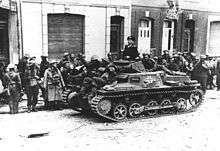
While they were still moving into position, they ran headlong into the German 256th Division, who were trying to flank Gort. Armoured cars of the 12th Lancers stopped the Germans at Nieuport itself. A confused battle raged all along the perimeter throughout 28 May. Command control on the British side disintegrated, and the perimeter was driven slowly inwards toward Dunkirk.[30]
Meanwhile, Erwin Rommel had surrounded five divisions of the French First Army near Lille. Although completely cut off, the French fought on for four days under General Molinié, thereby keeping seven German divisions from the assault on Dunkirk and saving an estimated 100,000 Allied troops.[30]
The defence of the perimeter held throughout 29–30 May, with the Allies falling back by degrees. On 31 May, the Germans nearly punched through at Nieuport, and the situation grew so desperate that two British battalion commanders had to personally man a Bren gun, with one colonel firing and the other loading. A few hours later, 2nd Battalion, Coldstream Guards rushed to reinforce the line near Furnes, where the British troops had been routed. 2nd Coldstream Guards restored order by shooting some of the fleeing troops, and turning others around at bayonet point. The British troops returned to the line, and the German assault was beaten back.[31]
In the afternoon of the same day, the Germans breached the perimeter near the canal at Bulskamp, but the boggy ground on the far side of the canal, with sporadic fire from the Durham Light Infantry, halted them. As night fell, the Germans massed for another attack at Nieuport. Eighteen RAF bombers found the Germans while they were still assembling, and scattered them with an accurate bombing run.[32]
Retreat to Dunkirk
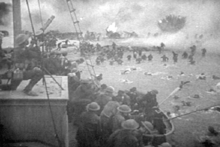
Also on 31 May, General Von Kuechler assumed command of all the German forces at Dunkirk. His plan was simple: he would launch an all-out attack across the whole front at 11:00 on 1 June. Strangely, Von Kuechler ignored a radio intercept telling him the British were abandoning the eastern end of the line to fall back to Dunkirk itself.[33]
The morning of 1 June was clear – good flying weather, in contrast to the bad weather that had hindered airborne operations on 30 and 31 May. (There were only two and a half good flying days in the whole operation.) Although Churchill had promised the French that the British would cover their escape, on the ground it was the French who held the line while the last remaining British soldiers were evacuated. Enduring concentrated German artillery fire and Luftwaffe strafing and bombs, the French stood their ground. On 2 June (the day the last of the British units embarked onto the ships),[Notes 2] the French began to fall back slowly, and by 3 June the Germans were about two miles (3 km) from Dunkirk. The night of 3 June was the last night of evacuations. At 10:20 on 4 June, the Germans hoisted the swastika over the docks from which so many British and French troops had escaped under their noses.[35][36][37]
Evacuation
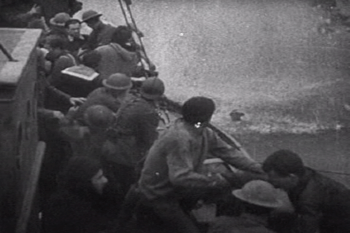
The War Office made the decision to evacuate British forces on 25 May. In the nine days from 27 May–4 June, 338,226 men escaped, including 139,997 French, Polish, and Belgian troops, together with a small number of Dutch soldiers, aboard 861 vessels (of which 243 were sunk during the operation). The historian Basil Liddell Hart says British Fighter Command lost 106 aircraft dogfighting over Dunkirk, the Luftwaffe lost about 135 – some of which were shot down by the French Navy and the Royal Navy; but MacDonald says the British lost 177 aircraft and the Germans lost 240.[35][37][38]
The docks at Dunkirk were too badly damaged to be used, but the East and West Moles (sea walls protecting the harbour entrance) were intact. Captain William Tennant—in charge of the evacuation—decided to use the beaches and the East Mole to land the ships. This highly successful idea hugely increased the number of troops that could be embarked each day, and indeed at the rescue operation's peak, on 31 May, over 68,000 men were taken off.[18][35]
The last of the British Army left on 3 June, and at 10:50, Tennant signalled Ramsay to say "Operation completed. Returning to Dover." However, Churchill insisted on coming back for the French, so the Royal Navy returned on 4 June in an attempt to rescue as many as possible of the French rearguard. Over 26,000 French soldiers were evacuated on that last day, but between 30,000 and 40,000 more were left behind and forced to surrender to the Germans.[39]
Aftermath
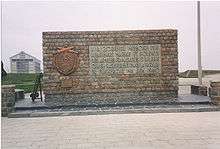
Following the events at Dunkirk, the German forces regrouped before commencing an operation called Fall Rot ("Case Red"), a renewed assault southward, starting on 5 June. Although two fresh British divisions had begun moving to France in an attempt to form a Second BEF, the decision was taken on 14 June to withdraw all the remaining British troops; an evacuation called Operation Ariel. By 25 June, almost 192,000 Allied personnel, 144,000 of them British, had been evacuated through various French ports.[40] Although the French Army fought on, German troops entered Paris on 14 June. The French government were forced to negotiate an armistice at Compiègne on 22 June.
The loss of materiel on the beaches was huge. The British Army left enough equipment behind to equip about eight to ten divisions. Discarded in France were, among huge supplies of ammunition, 880 field guns, 310 guns of large calibre, some 500 anti-aircraft guns, about 850 anti-tank guns, 11,000 machine guns, nearly 700 tanks, 20,000 motorcycles, and 45,000 motor cars and lorries. Army equipment available at home was only just sufficient to equip two divisions. The British Army needed months to re-supply properly and some planned introductions of new equipment were halted while industrial resources concentrated on making good the losses. Officers told troops falling back from Dunkirk to burn or otherwise disable their trucks (so as not to let them benefit the advancing German forces). The shortage of army vehicles after Dunkirk was so severe that the Royal Army Service Corps (RASC) was reduced to retrieving and refurbishing numbers of obsolete buses and coaches from British scrapyards to press them into use as troop transports. Some of these antique workhorses were still in use as late as the North African campaign of 1942.[41]
The Dean of St Paul's, Walter Matthews was the first to call the evacuation the "Miracle of Dunkirk" (on 2 June).[42]
A marble memorial to the battle stands at Dunkirk. The French inscription is translated as: "To the glorious memory of the pilots, mariners, and soldiers of the French and Allied armies who sacrificed themselves in the Battle of Dunkirk, May–June 1940."
The missing dead of the BEF are commemorated on the Dunkirk Memorial.
"Dunkirk Spirit"
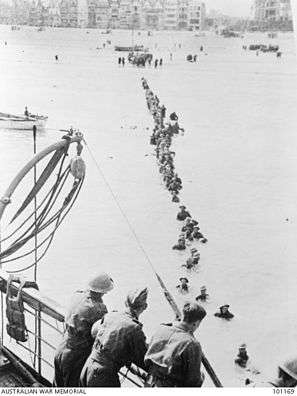
British propaganda later exploited the successful evacuation of Dunkirk in 1940, and particularly the role of the "Dunkirk little ships", very effectively. Many of them were private vessels such as fishing boats and pleasure cruisers, but commercial vessels such as ferries also contributed to the force, including a number from as far away as the Isle of Man and Glasgow. These smaller vessels—guided by naval craft across the Channel from the Thames Estuary and from Dover—assisted in the official evacuation. Being able to move closer into the beachfront shallows than larger craft, the "little ships" acted as shuttles to and from the larger ships, lifting troops who were queuing in the water, many waiting shoulder-deep in water for hours. The term "Dunkirk Spirit" still refers to a popular belief in the solidarity of the British people in times of adversity.[43]
Dunkirk Medal
A commemorative medal was established in 1960 by the French National Association of Veterans of the Fortified Sector of Flanders and Dunkirk on behalf of the town of Dunkirk. The medal was initially awarded only to the French defenders of Dunkirk but in 1970 the qualification was expanded to include British forces who served in the Dunkirk sector and their rescue forces, including the civilians who volunteered to man the "little ships".
The design of the bronze medal included the arms of the town of Dunkirk with "Dunkerque 1940" on the reverse.
See also
- 1940 Dunkirk Veterans' Association
- Military history of the United Kingdom during World War II
- British Army during the Second World War
- Marcus Ervine-Andrews (VC winner)
References
Notes
- ↑ "Monty" was later to win the Second Battle of El Alamein, plan the Normandy landings and Operation Market Garden at Arnhem. He rose to the rank of field marshal and became the most celebrated British general of the Second World War, but in 1940 he was commander of the 3rd Division under Brooke.
- ↑ General Alexander was one of the last to leave. Just before midnight on 2 June, Ramsay received the signal: "BEF evacuated".[34]
Citations
- 1 2 Taylor and Mayer 1974, p. 59.
- ↑ Castellow, Ellen. "Evacuation of Dunkirk"
- ↑ "Dunkirk Evacuation". Encyclopædia Britannica World War II. Retrieved 9 January 2016.
- ↑ The War in France and Flanders. Chapter XII
- ↑ Rickard, J. "Operation Dynamo, The Evacuation from Dunkirk, 27 May-4 June 1940." historyofwar.org. Retrieved 14 May 2008.
- 1 2 MacDonald 1986, p. 8.
- ↑ Frieser 2005, pp. 291–292.
- ↑ Shirer 1959, p. 879.
- ↑ Butler 2009, p. 151.
- ↑ Shirer 1959, p. 883.
- 1 2 Taylor and Mayer 1974, p. 60.
- ↑ Shirer 1959, p. 877.
- 1 2 3 Atkin 1990, p. 120.
- ↑ Kershaw 2008, p. 27.
- ↑ Bond 1990, pp. 104–105.
- ↑ Lord 1983, p. 148.
- ↑ Liddell Hart 1970, p. 40.
- 1 2 3 MacDonald 1986, p. 12.
- ↑ Sebag-Montefiore 2006, p. 250.
- ↑ Lord 1982, pp. 74–76.
- ↑ Shirer 1959, p. 882.
- ↑ Thompson 2009, pp. 174–178.
- ↑ Thompson 2009, p. 179.
- ↑ Thompson 2009, pp. 182–183.
- ↑ Thompson 2009, pp. 183–184.
- ↑ Thompson 2009, pp. 186–192, 215.
- ↑ Thompson 2009, p. 219.
- 1 2 Anderson, Professor Duncan. "Day of National Prayer." BBC. Retrieved: 30 July 2009.
- ↑ Sebag-Montefiore 2006, p. 303.
- 1 2 3 Liddell Hart 1970, p. 41.
- ↑ Lord 1982, p. 199.
- ↑ Lord 1982, p. 200.
- ↑ Lord 1982, p. 210.
- ↑ MacDonald 1986, p. 18.
- 1 2 3 MacDonald 1986, p. 16.
- ↑ Lord 1982, p. 246.
- 1 2 Liddell Hart 1970, p. 46.
- ↑ Shirer 1959, p. 884.
- ↑ Lord 1982, pp. 267–269.
- ↑ Butler 2009, pp. 296–305.
- ↑ Postan 1952, Chapter IV.
- ↑ Anderson, Professor Duncan. "Miracle' at Dunkirk/", writing BBC. Retrieved: 30 July 2009.
- ↑ Rodgers, Lucy. "The men who defined the 'Dunkirk spirit'." BBC, 14 May 2010. Retrieved: 30 July 2010.
Bibliography
- Atkin, Ronald. Pillar of Fire: Dunkirk 1940. Edinburgh: Birlinn Limited, 1990. ISBN 1-84158-078-3.
- Bond, Brian. Britain, France and Belgium 1939–1940. London: Brasseys, 1990. ISBN 0-08-037700-9.
- Butler, J. R. M., ed. The War in France and Flanders 1939–1940: Official Campaign History. Uckfield, UK: Naval & Military Press Ltd., 2009. ISBN 978-1-84574-056-6.
- Frieser, Karl-Heinz. The Blitzkrieg Legend: The 1940 Campaign in the West. Annapolis, Maryland: Naval Institute Press. 2005. ISBN 978-1-59114-294-2
- Holmes, Richard, ed. "France: Fall of". The Oxford Companion to Military History. New York: Oxford University Press, 2001. ISBN 0-19-866209-2.
- Hooton, E.R. Luftwaffe at War; Blitzkrieg in the West. London: Chevron/Ian Allen, 2007. ISBN 978-1-85780-272-6.
- Keegan, John. The Second World War. New York: Viking Penguin, 1989. ISBN 0-670-82359-7.
- Kershaw, Ian. Fateful Choices: Ten Decisions That Changed the World, 1940–1941. London: Penguin Books, 2008. ISBN 978-0-14-101418-0.
- Kilzer, Louis. Hitler's Traitor: Martin Bormann and the Defeat of the Reich. New York: Presidio Press, 2000. ISBN 0-89141-710-9.
- Liddell Hart, B.H. History of the Second World War. New York: G.P. Putnam, 1970. ISBN 0-306-80912-5.
- Lord, Walter. The Miracle of Dunkirk. New York: The Viking Press, 1982 / London: Allen Lane, 1983. Citations from the Wordsworth Military Library reprint of 1998. ISBN 1-85326-685-X.
- MacDonald, John. Great Battles of World War II. Toronto, Canada: Strathearn Books Limited, 1986. ISBN 0-86288-116-1.
- McEwan, Ian. Atonement. London: Jonathan Cape, 2001. ISBN 0-224-06252-2.
- McGlashan, Kenneth B. with Owen P. Zupp. Down to Earth: A Fighter Pilot Recounts His Experiences of Dunkirk, the Battle of Britain, Dieppe, D-Day and Beyond. London: Grub Street Publishing, 2007. ISBN 1-904943-84-5.
- Murray, Willamson. Strategy for Defeat: The Luftwaffe 1935–1945. Princeton, New Jersey: University Press of the Pacific, 2002. ISBN 0-89875-797-5.
- Murray, Williamson and Allan R. Millett. A War to Be Won: Fighting the Second World War. Cambridge, Massachusetts: Belknap Press, 2000. ISBN 0-674-00163-X.
- Postan Michael M.History of the Second World War: British War Production, London: HMSO, 1952.
- Salmaggi, Cesare and Alfredo Pallavisini. 2194 Days of War: An Illustrated Chronology of the Second World War. New York: Gallery Books, 1993. ISBN 0-8317-8885-2.
- Sebag_Montefiore, Hugh. Dunkirk: Fight to the Last Man. London: Penguin Books, 2006. ISBN 978-0-141-02437-0.
- Shirer, William L. The Rise and Fall of the Third Reich: A History of Nazi Germany. New York: Simon & Schuster, 1959. ISBN 0-330-70001-4.
- Taylor, A.J.P. and S.L. Mayer, eds. A History Of World War Two. London: Octopus Books, 1974. ISBN 0-7064-0399-1.
- Thomas, Nick. RAF Top Gun: Teddy Donaldson CB, DSO, AFC and Bar, Battle of Britain Ace and World Air Speed Record Holder. London: Pen and Sword, 2008. ISBN 1-84415-685-0.
- Thompson, Major General Julian. Dunkirk: Retreat to Victory. London: Pan Books, 2009. ISBN 978-0-330-43796-7.
- Weinberg, Gerhard L. A World at Arms. New York: Cambridge University Press, 1994. ISBN 0-521-44317-2.
- Wilmot, Chester. The Struggle for Europe. Old Saybrook, Connecticut: Konecky & Konecky, 1952. ISBN 1-56852-525-7
External links
- War Museum of Dunkirk
- Dunkirk, Operation Dynamo – A post-blog of the Battle of Britain 1940
- Battle of Dunkirk short documentary with footage
- Maps of the battle from the BBC
Coordinates: 51°02′03″N 2°22′37″E / 51.0343°N 2.37682°E